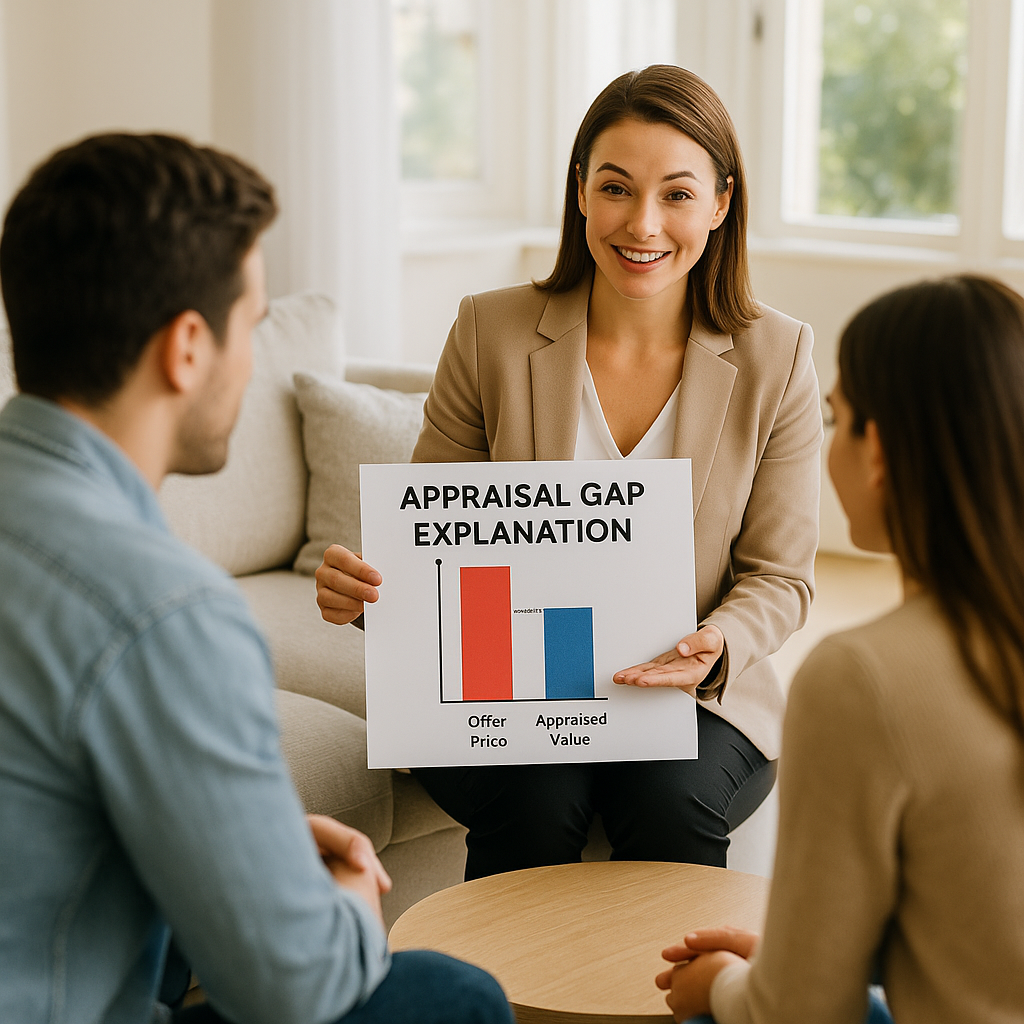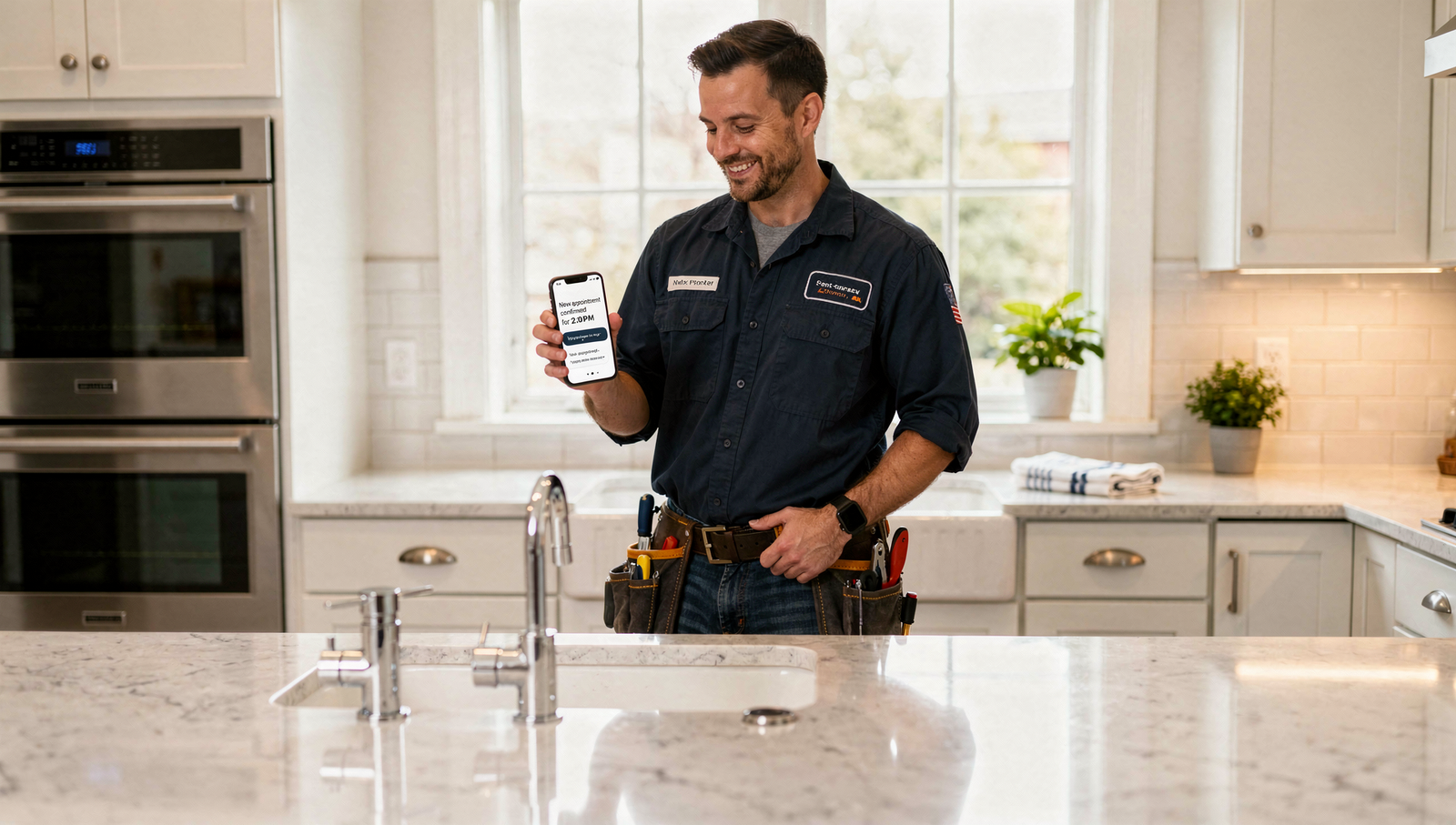Explaining Appraisal Gaps: How Realtors Can Guide Buyers Confidently
If you’ve ever struggled with explaining appraisal gap to buyers real estate, you’re not alone. It’s one of those moments in a transaction where expectations and emotions collide. The buyer falls in love with a home, offers over asking to beat the competition, and then the appraisal comes in low. Suddenly, the deal feels shaky. As a Realtor, this is your opportunity to step up, educate, and guide with confidence.
This post will give you simple talking points, real-world examples, and strategic advice to help buyers understand appraisal gaps clearly, build trust, and move forward with clarity.
Explaining appraisal gap to buyers real estate: what it really means
Let’s start with the basics. An appraisal gap happens when the appraised value of a property comes in lower than the agreed-upon purchase price.
For example, if your buyer offers $410,000 for a home but the appraisal report values it at $390,000, there’s a $20,000 appraisal gap.
That gap doesn’t automatically kill the deal…it just means the lender will only finance the appraised amount, not the purchase price. The buyer must decide how to cover the difference or renegotiate terms.
Why buyers need to understand this early
Many buyers assume their pre-approval means “the bank will cover it.” You can help by explaining early that lenders lend on appraised value, not the offer price.
When clients understand this upfront, they’re calmer and more decisive if a low appraisal happens. A simple visual or explainer video on your website can help too…learn how to add these tools on your pages with Best Free Tools for Realtors.
Why appraisal gaps happen
Buyers are often confused or frustrated when appraisals come in low. Here’s how you can explain the common causes in plain English.
Market momentum outpacing data – Appraisers use past sales to determine value, so if prices are rising fast, the data can lag behind current offers.
Unique property features – Homes with special upgrades or limited comps may be undervalued if nearby sales don’t show similar attributes.
Competitive bidding wars – When multiple buyers bid above list price, the sale price can exceed what recent comps justify.
Inexperienced or out-of-area appraisers – Occasionally, appraisers unfamiliar with a market undervalue a home because they miss key local nuances.
Explaining these points helps buyers see that a low appraisal isn’t a reflection of their judgment…it’s a quirk of how the system works.
How to prepare buyers for appraisal gaps before they happen
One of the best ways to build trust is to set expectations from the start. Here’s how to position yourself as both a strategist and a calming presence.
1. Educate during the consultation.
Walk buyers through the appraisal process in your initial buyer meeting. Use visuals or a short guide to explain how value is determined. You can even record a short video for your site using advice from YouTube Script Ideas for Realtors: How to Create Videos That Get Views.
2. Build “gap-ready” offers.
If the market is competitive, teach clients how to include an appraisal gap clause in their offer. This clause commits them to cover part (or all) of the gap with cash if the appraisal comes in low.
3. Emphasize financial comfort zones.
Coach buyers to focus on what they’re comfortable paying, not just what they can qualify for. This mindset keeps emotions in check when bidding gets heated.
4. Encourage preemptive discussions with lenders.
Before making offers, have your buyers talk to their lender about options for covering potential gaps. A proactive conversation can save days of stress later.
These steps show leadership and transparency…two traits that buyers remember long after closing.

How to handle a low appraisal like a pro
When that dreaded low appraisal hits your inbox, don’t panic. Here’s how to walk buyers through their choices calmly and confidently.
1. Review the appraisal report
Look for errors, missed comps, or data points that could support a higher value. Sometimes appraisers miss recent pending sales that justify your price. If you find issues, you can request a reconsideration of value.
2. Renegotiate with the seller
Explain to your buyers that a low appraisal isn’t the end. Often, the seller will agree to reduce the price, meet halfway, or offer concessions to keep the deal alive.
Use a calm tone when guiding this conversation. You might say:
“The appraisal came in at $390,000. Let’s review the report together and discuss whether we can negotiate with the seller to close that $20,000 gap.”
3. Bridge the gap creatively
If renegotiation doesn’t solve it, discuss options like:
Paying the difference in cash
Splitting the difference with the seller
Re-evaluating the loan type or down payment
Walk through the math so buyers understand the exact financial impact. Transparency builds confidence.
4. Remind them of their long-term goals
If the home still fits their lifestyle and long-term plans, help them see beyond the short-term numbers. A small gap today can be insignificant over years of ownership.
This is where emotional intelligence matters most. The ability to guide clients through uncertainty is what separates good agents from great ones.
Real-world example: turning panic into confidence
Picture this scenario.
You have a buyer named Alex who fell in love with a $500,000 home. After winning a multiple-offer situation, the appraisal came back at $480,000. Alex immediately panics, assuming he’s made a huge mistake.
You stay calm and explain:
“Alex, this is an appraisal gap. It doesn’t mean you overpaid…it means the appraiser’s data hasn’t caught up to the market yet. We have three options: we can appeal the appraisal, ask the seller to adjust, or you can choose to cover some of the gap if you’re comfortable.”
Alex chooses to split the difference with the seller. You save the deal, keep his trust, and earn a glowing testimonial later.
Situations like these are golden opportunities to build authority. For more on turning moments of tension into trust, read Real Estate Website Conversion Tips.
How to communicate appraisal gaps effectively
Realtors who master communication thrive, especially in uncertain markets. Here’s how to make complex financial situations easy to grasp.
Use analogies. Compare appraisals to a “report card” for the home…useful but sometimes missing context.
Keep the tone calm and educational. Avoid jargon like “loan-to-value ratio.” Say, “The bank is simply using this report to decide how much they’ll lend.”
Provide visual clarity. Use a chart or graphic showing purchase price vs. appraised value. Visuals stick better than numbers alone.
Reassure, don’t react. Buyers take their emotional cues from you. If you’re composed, they will be too.
For creative ways to make your buyer education materials look more professional, explore Branding Tips for Solo Agents.
How appraisal gaps affect your business reputation
The way you handle appraisal gaps can directly impact your referrals and repeat business. Buyers remember how you guided them when things got stressful.
Agents who communicate clearly and offer solutions are seen as experts who truly protect their clients’ interests. This not only boosts referrals but also gives you strong content ideas for your blog and social media.
For example:
Write a blog post titled “What to Do If Your Appraisal Comes In Low”
Film a short video explaining the three options buyers have
Create an infographic summarizing your process
Each of these assets can help you attract new leads. Combine them with strategic online promotion using tips from Facebook Ads vs Google Ads for Realtors to amplify your reach.
Digital tools that simplify the appraisal process
Technology can make your buyer consultations smoother and more professional.
Use CRM automations to send educational videos, FAQs, and follow-up checklists after showings. For a detailed list of platforms that streamline these workflows, visit Top 5 Best CRMs for Realtors.
You can also build resource pages on your website explaining appraisal gaps, financing basics, and negotiation tips. When paired with SEO-focused blog posts, these pages attract traffic from buyers actively searching for answers. Learn how to rank those posts in How to Rank Higher on Google Maps.
Key takeaways for Realtors
Start early: Explain appraisal gaps in your buyer consultations.
Use stories and visuals: They make the concept easier to understand.
Stay calm and proactive: Your confidence helps clients make rational choices.
Leverage technology: Automate follow-ups and create online resources for recurring education.
Promote your expertise: Use YouTube, blog posts, and guides to position yourself as the go-to real estate educator in your area.
When you consistently educate clients about complex topics like appraisal gaps, you become more than a salesperson…you become a trusted advisor.
Conclusion
Explaining appraisal gap to buyers real estate is one of the most valuable skills you can master. When you simplify the concept, anticipate questions, and communicate with empathy, you build credibility that lasts for years.
Use these strategies to guide your clients confidently through the process and strengthen your professional brand in the process.
If you’d like to combine client education with a luxury, lead-optimized website that helps convert curious visitors into warm leads, book a free consultation with Digital Dream Homes today.
Matt Pieczarka
Want a Free Website Audit?
Fill out your information below and we will send you a personal screen share video of tips on how to make your actual website better!
See How Many Closings You're Losing to Zillow!
Click Here to Use our Calculator to See How Many Clients Zillow is Taking From You Per Year!
7 Storytelling Plays That Turn Plumbing Websites Into Lead Machines
7 Storytelling Plays That Turn Plumbing Websites Into Lead Machines Facebook X LinkedIn Threads Email The tricks learned in this video and blog post have gotten one of our clients
9 Plumbing Company Branding Strategies That Get More Calls
9 Plumbing Company Branding Strategies That Get More Calls Facebook X LinkedIn Threads Email The tricks learned in this video and blog post will help you get your brand to as many
7 Plumbing Membership Plans Benefits That Boost Profit
7 Plumbing Membership Plans Benefits That Boost Profit Facebook X LinkedIn Threads Email The tricks learned in this blog post have increased recurring revenue for one of our plumbi
7 Plumbing Services Pricing Tiers That Sell Like Crazy
7 Plumbing Services Pricing Tiers That Sell Like Crazy Facebook X LinkedIn Threads Email The tricks learned in this video and blog post have gotten one of our clients an average of
7 Plumbing Service Pricing Strategies To Boost Profit
7 Plumbing Service Pricing Strategies To Boost Profit Facebook X LinkedIn Threads Email The tricks learned in this video and blog post have gotten one of our clients an average of
7 Plumbing Maintenance Agreement Strategies That Drive Revenue
7 Plumbing Maintenance Agreement Strategies That Drive Revenue Facebook X LinkedIn Threads Email Most plumbers leave recurring revenue on the table. These maintenance agreement str
AI Tools for Plumbing Businesses That Book Jobs 24/7
AI Tools for Plumbing Businesses That Book Jobs 24/7 Facebook X LinkedIn Threads Email The AI tricks learned in this blog post have gotten one of our plumber clients an average of
Hiring Plumbers And Onboarding Program For Rockstar Crew Growth
Hiring Plumbers And Onboarding Program For Rockstar Crew Growth Facebook X LinkedIn Threads Email The strategies in this blog post helped one of our plumbing clients cut onboarding
7 SMART Goals For Plumbing Growth In 90 Days
7 SMART Goals For Plumbing Growth In 90 Days Facebook X LinkedIn Threads Email The strategies in this blog post helped one of our clients get organized and grow his plumbing busine









